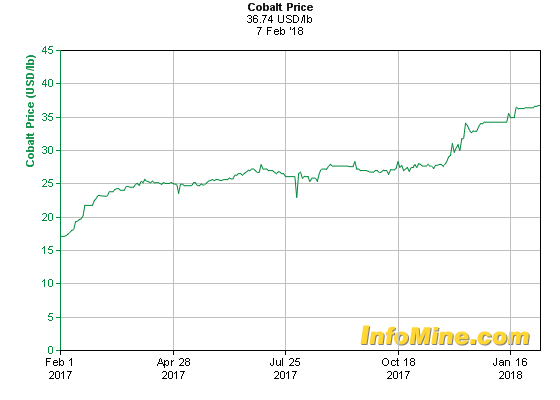Cobalt 27 offers pure play exposure and unique strategy

By Peter Kennedy
 Cobalt prices continued their steady ascent last week in a move that is good news for Cobalt 27 Capital Corp. [KBLT-TSXV, 270-FSE], a company that offers pure play exposure to cobalt, an integral element in key technologies of the electric vehicle and battery energy storage markets.
Cobalt prices continued their steady ascent last week in a move that is good news for Cobalt 27 Capital Corp. [KBLT-TSXV, 270-FSE], a company that offers pure play exposure to cobalt, an integral element in key technologies of the electric vehicle and battery energy storage markets.
Analysts say Cobalt 27 is in a unique position as it looks to transform itself from a physical holding company into a hybrid physical/streaming company after recently raising $97.8 million from the sale of common shares priced at $10.50 a share.
The offering was led by an underwriting syndicate led by TD Securities Inc. and Scotiabank, which exercised an over-allotment option of 1.2 million shares at the same price.
On February 8, 2018, the shares were trading at $11.35 in a 52-week range of $21 and $3.40, leaving the company with a market cap of $281.7 million based on 24.8 million shares outstanding.
Cobalt 27 holds physical cobalt and is focused on growing a cobalt-focused portfolio of streams, exploration-stage cobalt royalties, and direct interest in mineral properties containing cobalt.
Physical cobalt holdings
The company holds 2,982.9 tonnes of physical cobalt, consisting of 2,270.3 tonnes of premium grade cobalt and 712.6 tonnes of standard grade material. All cobalt owned by the company is insured and stored in metal drums in secure warehouses located in Baltimore, Antwerp and Rotterdam.
NSR royalties
The company has acquired seven net smelter return royalties on exploration-stage properties containing cobalt. They include four properties in Ontario, two in the Canadian Yukon and one in British Columbia.
One of them, located in the Yukon, is Golden Ridge Resources Ltd.’s [GLDN-TSXV] North Canol Project, where a re-evaluation of the project potential in 2017 identified highly anomalous cobalt values of up to 906 ppm in reconnaissance stream sediment samples which were taken across the property in 2011.
The cobalt price has recently been driven higher by news from the Democratic Republic of Congo, which accounts for roughly 54% of the world’s production. Published reports by Bloomberg and others say the country’s new proposed mining code (approved by lawmakers but not yet signed by DRC President Joseph Kabila) permits the DRC to raise the royalty on cobalt to 10% from 2% if the government categorizes the mineral as “strategic substance.”
A Bloomberg report said the African nation’s parliament went ahead with the changes to the 2002 code even after Ivan Glasenberg, President of Swiss metals trading giant Glencore visited the country and had a personal meeting with Kabila.
This is all positive for Cobalt 27, according to a report by Scotiabank equity analyst Michael Doumet. Â Â Â Â “While still early days in the Cobalt 27 story, Doumet sees continued upside in the shares from cobalt price [price] appreciation and value accretive transactions.”
Cobalt recently traded a nine-year high of US $34.25 a pound, a move that was fueled in part by speculation about how much cobalt will be used to manufacture lithium ion batteries used in the production of electric vehicles.
In the last 12 months alone, the price of cobalt has spiked by 150%. Cobalt 27 is optimistic that overall cobalt demand will eventually rise by a compounded annual growth rate of about 6.9% from 2016 to 2020, with battery-related demand expected to grow at an 11.7% annual growth rate from 2016 to 2022.
Cobalt 27 notes that the current cycle of rising cobalt prices really started with the advent of mobile electronic devices such as smartphones, which use an average of 5 grams to 20 grams of metal per device. “However, the electric vehicle revolution is forcing demand to scale exponentially, using about 4 kilograms to 14 kilograms per vehicle,” the company said.
Cobalt 27 said its existing stockpiles of cobalt are currently the largest outside of China.
